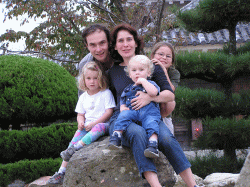
@@@
@

|
@
@Dr. Jianshe Lei is a GRC postdoctral fellow from June 2003. He had ever
visited GRC twice. His main interest is the theory and application of seismic
tomography.
@Dr. Lei's first work in GRC is on the seismic ray path variations of
P, pP, PP, and PcP phases in a global 3-D Earth model (Zhao, 2001) with
lateral depth variations of the Moho, 410, and 660 km discontinuities.
He and Prof. Zhao found that the changes of ray paths and travel times
amount up to 77 km and 3.9 s, respectively. The results suggest that if
the blocks or grid nodes adopted for inversion are relatively large (3-5
degrees) and only a low resolution 3-D model is estimated, 1-D ray-tracing
is feasible. But if fine blocks or grid nodes are used to determine a high-resolution
model, 3-D ray-tracing becomes necessary and important for the global tomography.
Now this work has been accepted for its publication by the journal of PEPI
(Physics of the Earth and Planetary Interiors).
@Recently he and Prof. Zhao are working on the seismic structure and origin of Changbai intraplate volcano in Northeast Asia. He picked up over 1000 arrival times from the seismic waveforms. By using a teleseismic tomography method, for the first time, he and Prof. Zhao have succeeded in imaging the 3-D seismic structure beneath the Changbai intraplate volcano. It is found that low velocity anomalies (2-3%) extend down to 400 km depth beneath the Changbai volcano. The global tomography also shows low velocity anomalies beneath it (Zhao, 2001). These results suggest that the Changbai intraplate volcano is not a hotspot but a kind of the back-arc volcano caused by the dehydration and stagnancy processes of the subducting Pacific slab.
@Dr. Lei is a kind and helping man. Although being always busy, he often
spends much time to help the students in the GRC Seismological Lab. On
Sunday he often plays badminton, walks and climbs the Matsuyama Castle
with some students together. But on week days he works hard, efficiently
and productively. He likes very much the GRC Seismological Lab, and enjoys
the collaboration with Prof. Zhao. He is enjoying the nice work environment
for research in GRC. GRC Director Prof. Irifune, Prof. Zhao, Dr. Yamada,
Dr. Inoue, and Dr. Yamazaki and all the post-doctors and students in GRC
are very kind, nice, and helpful, and every staff members are also cooperative
and helpful. He likes Matsuyama very much, and hopes to keep a long and
productive cooperation with GRC, Ehime University in the future.

 |
@Dr. Xi Liu is a post-doctor fellow of the Japanese Society for the Promotion of Science (JSPS) and currently hosted by the Geodynamics Research Center (GRC) of Ehime University. His JSPS post-doctor fellowship started from June, 2003. His major interest here is in high-pressure experimental geochemistry and geophysics, using the multi-anvil apparatus.
@To Dr Liu, experimenting with the multi-anvil apparatus at GRC is a new
challenge and the skills and the techniques required in preparing a multi-anvil
experiment are fascinating. He hopes that he can manage to learn how to
make successful multi-anvil experiments and carry out some interesting
and important scientific projects as well.
@His present scientific research at GRC is about the mutual solubility of some simple oxides in their own stable mineralogical form under the pressure-temperature conditions of the upper and lower mantle of the Earth. He also is going to study the changes of the geophysical properties of these phases caused by the incorporation of other oxides into their structures. His research certainly will enhance our understanding about the behavior of the mantle.
@Dr Liu and his family (wife Peng Huichun and two kids: Yixiang, almost
5 years old, and Yihua, born in Matsuyama in Dec., 2003!) are happily experiencing
their Japanese lives. They are very grateful to the faculty and staff here
at the GRC for their kind helps.


|
@Dr. Fabrice Brunet is a visiting scientist (JSPS fellowship) from the
geology department of the Ecole normale superieure in Paris. He will stay
in Matsuyama for ten months with his wife, Sophie, and their three children
(Mathilde, 7, Anouk, 4, and Marius, 2 years old). His present scientific
work mainly focuses on the crystal-chemistry of high-pressure minerals
and especially accessory minerals. As a matter of fact, whereas major mantle
silicates define the bulk composition of the mantle and its physical properties,
low-concentration phases may host the minor and trace-elements which are
commonly used to trace geophysical processes. The experimental study of
accessory phases and minor elements under high pressures and temperatures
is a difficult task because it requires to identify and characterise phases
of very low concentration. The strategy of Dr. Brunet's work at GRC will
be to combine his knowledge of the chemistry of natural rocks with our
understanding of mantle mineralogy and our experimental expertise in the
field of high pressures and temperatures. The experimental facilities here,
including the use of synchrotron radiation, appear as particularly well
suited to tackle the scientific problem that he came up with.
@Fabrice Brunet and his wife, Sophie, are fond of japanese culture. If
you would visit their home in Matsuyama to witness the French living, you
might be disappointed. You will sit down on tatamis, eat rice and sashimi
with chopsticks and drink green tea or sake. The two daughters who go to
school at Matsuyama may sing Japanese songs for you. The slight smell of
black coffee might be one of the few apparent remainder of the French living
style. Coming from an overcrowded city, they also very much enjoy the green
in the Matsuyama surrounding. They are especially delighted with the colour
of rice fields and orange trees. Fabrice Brunet and his family are grateful
to the whole GRC staff for his kind support and for making their life so
pleasant.
©@Back
@@@@ Jianshe Lei
@@@@i@Φ€υj
@@@@ @@Xi Liu
iwUOlΑΚ€υj
@@@Fabrice Brunet
iwUOl΅γΩ€υj


